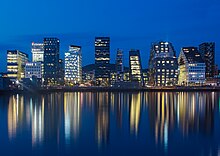 | |
| Calendar year | |
Trade organisations | EFTA, OECD, WTO, EEA and others |
Country group | |
| Statistics | |
| Population | 5,367,580 (1 January 2020)[3] |
| GDP | |
| GDP rank | |
GDP growth | |
GDP per capita | |
GDP per capita rank | |
GDP by sector |
|
| 3.3% (2024 est.)[4] | |
Population below poverty line | |
| 24.7 low (2023)[7] | |
| |
Labour force | |
Labour force by occupation |
|
| Unemployment | |
Average gross salary | €55,200 annual |
| €40,500 annual | |
Main industries | |
| External | |
| Exports | $102.8 billion (2017 est.)[5] |
Export goods | petroleum and petroleum products, machinery and equipment, metals, chemicals, ships, fish |
Main export partners |
|
| Imports | $95.06 billion (2017 est.)[5] |
Import goods | machinery and equipment, chemicals, metals, foodstuffs |
Main import partners |
|
FDI stock | |
| $73.13 billion (2024 est.)[4] | |
Gross external debt |
|
| Public finances | |
| 36.5% of GDP (2017 est.)[5][note 1] | |
| +4.4% (of GDP) (2017 est.)[5] | |
| Revenues | 217.1 billion (2017 est.)[5] |
| Expenses | 199.5 billion (2017 est.)[5] |
| Economic aid | $4.0 billion (donor), 1.1% of GDP (2017) [1] |
| $65.92 billion (31 December 2017 est.)[5] | |
All values, unless otherwise stated, are in US dollars. | |


The economy of Norway is a highly developed mixed economy with state-ownership in strategic areas. Although sensitive to global business cycles, the economy of Norway has shown robust growth since the start of the industrial era. The country has a very high standard of living compared with other European countries. Norway's modern manufacturing and welfare system rely on a financial reserve produced by exploitation of natural resources, particularly North Sea oil.[19][20][21][22][23] Among OECD nations, Norway has a highly efficient and strong social security system; social expenditure stood at roughly 22.6% of GDP.[24][25][26]
- ^ "World Economic Outlook Database, April 2024". IMF.org. International Monetary Fund.
- ^ "World Bank Country and Lending Groups". datahelpdesk.worldbank.org. World Bank. Retrieved 29 September 2019.
- ^ "Population on 1 January". ec.europa.eu/eurostat. Eurostat. Retrieved 13 July 2020.
- ^ a b c d e f g h i "World Economic Outlook (October 2024)". imf.org. International Monetary Fund.
- ^ a b c d e f g h i j k l m "The World Factbook". CIA.gov. Central Intelligence Agency. Retrieved 29 June 2019.
- ^ "People at risk of poverty or social exclusion". ec.europa.eu/eurostat. Eurostat.
- ^ "Gini coefficient of equivalised disposable income – EU-SILC survey". ec.europa.eu/eurostat. Eurostat.
- ^ "Human Development Index (HDI)" (PDF). hdr.undp.org. HDRO (Human Development Report Office) United Nations Development Programme. Retrieved 13 March 2024.
- ^ "Human Development Reports: Norway. IHDI–Inequality-adjusted HDI". hdr.undp.org. UNDP. Retrieved 13 March 2024.
- ^ "Corruption Perceptions Index". Transparency International. 30 January 2024. Archived from the original on 30 January 2024. Retrieved 15 July 2024.
- ^ a b "Labor Force Survey". ssb.no. Statistics Norway. Retrieved 29 September 2020.
- ^ "Employment rate by sex, age group 20-64". ec.europa.eu/eurostat. Eurostat. Retrieved 20 July 2024.
- ^ "Arbeidsledighet i Norge".
- ^ "Unemployment rate by age group". data.oecd.org. OECD. Retrieved 8 September 2020.
- ^ a b SSB, https://www.ssb.no/utenriksokonomi/utenrikshandel/statistikk/utenrikshandel-med-varer/artikler/norges-viktigste-handelspartnere, 2023
- ^ "Sovereigns rating list". Standard & Poor's. Archived from the original on 28 September 2011. Retrieved 26 May 2011.
- ^ a b c Rogers, Simon; Sedghi, Ami (15 April 2011). "How Fitch, Moody's and S&P rate each country's credit rating". The Guardian. Archived from the original on 1 August 2013. Retrieved 31 May 2011.
- ^ "Scope affirms the Kingdom of Norway's AAA rating with Stable Outlook". Scope Ratings. Retrieved 6 September 2024.
- ^ The economic effects of north sea oil on the manufacturing sector Archived 2 February 2014 at the Wayback Machine Hilde Christiane Bjørnland
- ^ Overview of the Norwegian oil and gas sector Archived 23 May 2013 at the Wayback Machine Embassy of Denmark, Oslo
- ^ "Archived copy" (PDF). Archived from the original (PDF) on 20 June 2013. Retrieved 28 December 2012.
{{cite web}}: CS1 maint: archived copy as title (link) - ^ The Oil Industry and Government Strategy in the North Sea Øystein Noreng
- ^ "The rich cousin". The Economist. 1 February 2013. Archived from the original on 1 February 2013. Retrieved 1 February 2013.
- ^ Kenworthy, Lane (1999). "Do Social-Welfare Policies Reduce Poverty? A Cross-National Assessment" (PDF). Social Forces. 77 (3): 1119–1139. doi:10.2307/3005973. JSTOR 3005973. Archived (PDF) from the original on 10 August 2013.
- ^ Moller, Stephanie; Huber, Evelyne; Stephens, John D.; Bradley, David; Nielsen, François (2003). "Determinants of Relative Poverty in Advanced Capitalist Democracies". American Sociological Review. 68 (1): 22–51. doi:10.2307/3088901. JSTOR 3088901.
- ^ "Social Expenditure – Aggregated data". Organisation for Economic Co-operation and Development.
Cite error: There are <ref group=note> tags on this page, but the references will not show without a {{reflist|group=note}} template (see the help page).